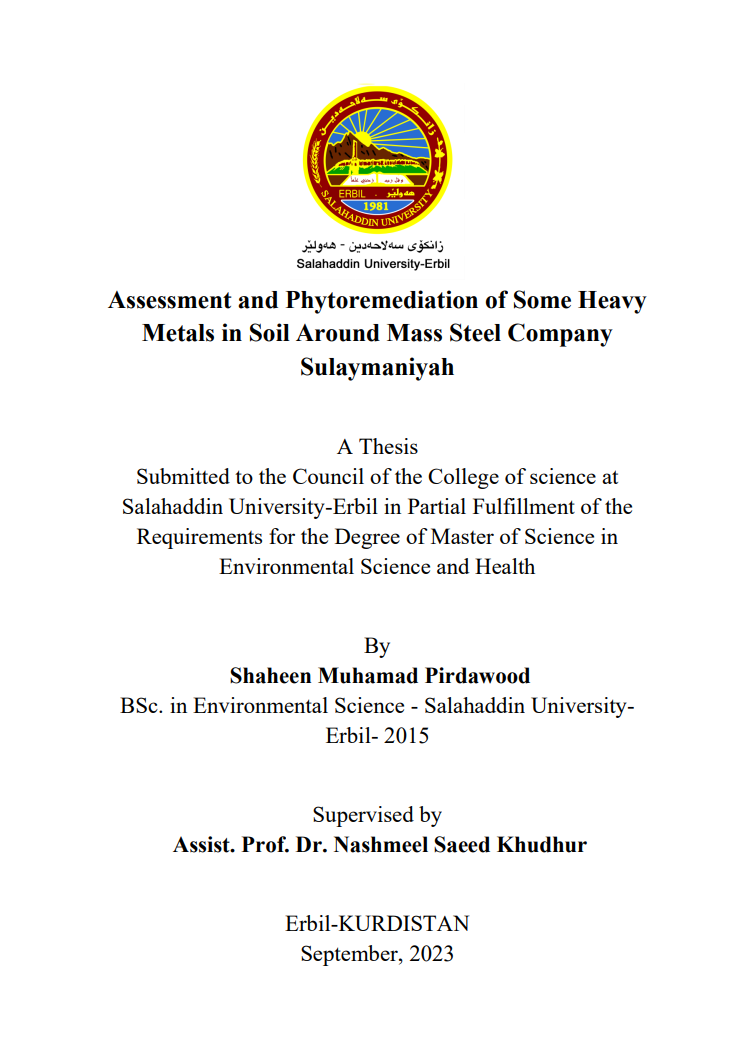
SUMMARY
This study was carried out during the period from August 2021 until February 2022. Soil samples were gathered from 32 locations in the surface (0-30) layer from Mass Steel Company. Four directions were selected including north, south, east and west, and each with four distinct circumferential belts with distances of 25, 50, 75, and 100 meters of the company. Eleven trace metals, including: barium (Ba), cobalt (Co), chromium (Cr), copper (Cu), nickel (Ni), strontium (Sr), vanadium (V), zinc (Zn), zirconium (Zr), lanthanum (La) and lead (Pb) were examined, beside the soil crystalline structure including: silica (SiO2), aluminum oxide (Al2O3), ferric oxide (Fe2O3), calcium oxide (CaO), magnesium oxide (MgO), sodium oxide (Na2O), potassium oxide (K2O), titanium dioxide (TiO2), manganese oxide (MnO), phosphorus pentoxide (P2O5) and loss on ignition (LOI). Six specialization indices were applied including: CF, Cdeg, PLI, ECI, ER and RI were calculated for evaluating soil pollution status.
Maximum value for (Ba, Co, Cr, Cu, V, Zr) were recorded in north from distance 75 m away from the center company and minimum value (188 ppm, 164.5 ppm, 160.5 ppm, 114 ppm, 20 ppm, 111.5 ppm ) for (Ba, Cr, Sr, V, Zn, Zr) were recorded in east from distance 50 m away from the center of company.
Direction and distance showed significant effects on Co, Cu, Ni, Sr, Zr, La, Pb, SiO2, Al2O3, Fe2O3, CaO, MgO, Na2O, K2O, TiO2, MnO, P2O5 and LOI. Maximum values of SiO2 (47.91), Fe2O3 (6.111), Na2O (0.927), K2O (1.559), TiO2 (0.628), MnO (0.138) and P2O5 (0.327) were recorded in north – 75 m away from the company, while minimum Al2O3 (8.535), MgO (3.415), K2O (1.128) and TiO2 (0.475) were recorded in south – 100 m away from the company.
Moreover, Pearson correlation analysis showed that the crystalline properties (except for CaO) were positively correlated with the studied metals in most of the cases except for Ni in which negatively correlated with most of the metals and crystalline properties of the studied soils.
Pollution indices analysis showed that Ni and Pb have caused considerable to very high pollution, however, Pb generally showed very high pollution in all studied sites by observing the highest contamination factor (CF) in 50 m east of the company. The degree of contamination in every direction is very high showing a considerable degree of contamination (Cdeg = 16 – 32). Pollution load index (PLI) showed deterioration in the site quality in the north 50 m, 75 m, 100 m by PLI = 1.38, 1.42, 1.39 respectively, the west direction all showed deterioration in the site quality as well as the direction south 50 m and 75 m showed deterioration in the site quality (PLI = 1.23, 1.01) respectively.
Mild ecological risk factor was recorded for Cr, Cu and Zn in all studied directions, whereas, lead showed strength ecological risk factor in south 50 m away with value of 40.833, and east 25 m away with value of 45.000, east 50 m away with value of 52.130 and east 100 m away with values of 49.259 as well as in the west 100 m away with values of 45.556. Potential ecological risk index (RI) showed mild potential ecological risk in all directions and distances.
Phytoremediation experiment showed that Tradescantia pallida is an efficient plant in removing heavy metals from polluted soils. Generally, unpaired showed that Tradescantia pallida in the treated pots with compost have significant and greater metal uptake; moreover, statistical analysis showed that Tradescantia pallida significantly removed metals from soil and revealed significant bioaccumulation factor.
